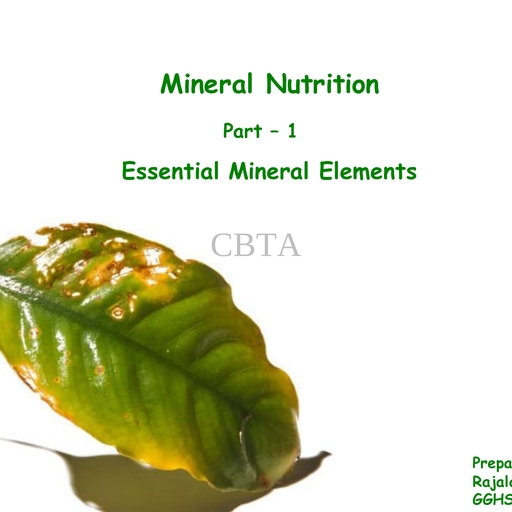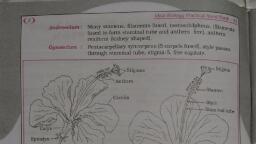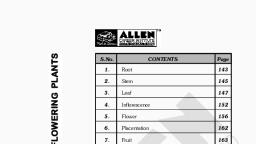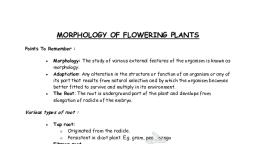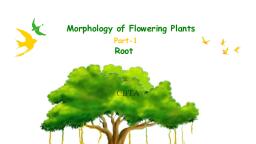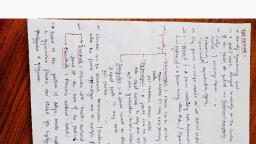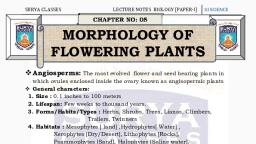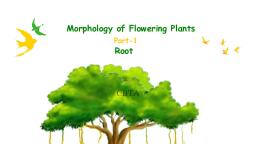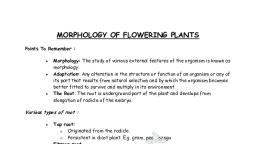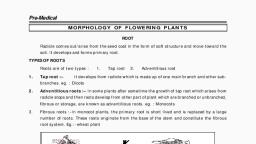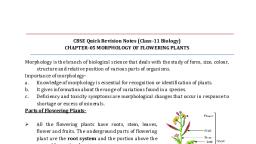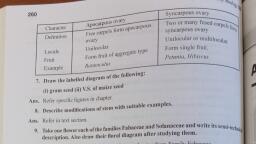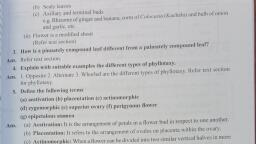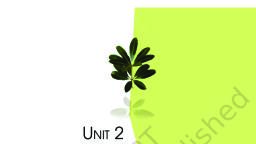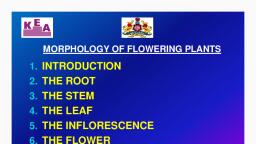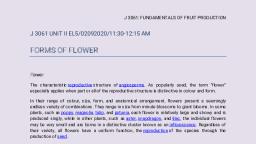Page 3 :
Root, ❖ In majority of the dicotyledonous plants the radicle, develops into a primary root which grows into the soil., ❖ It bears lateral roots of several orders that are, referred to as secondary, tertiary, etc. roots., , CBTA, , Tertiary root
Page 4 :
Different types of root system, 1) Taproot system, In dicotyledonous plants the radicle develops into a, primary root which branches to form secondary &, teritary roots, , CBTA
Page 5 :
2) Fibrous root system, In monocotyledonous plants, the primary root is, short lived and is replaced by a large number of roots., These roots originate from the base of the stem, , CBTA
Page 6 :
3) Adventitious roots, In some plants, roots arise from parts of the plant, other than the radicle ., Eg : Grass, Monstera ,Banyan tree, , CBTA
Page 7 :
The main functions of the root system, CBTA, 1) Absorption of water, and minerals from the soil, , 2) Anchorage to the plant into the soil, 3) Storage of reserve food material, 4) Synthesis of plant growth regulators.
Page 8 :
The regions of the root-tip, ❖ Root cap –, It protects the tender apex of the root., ❖ Region of meristematic activity –, The cells of this region are very small,, , CBTA, thin-walled and with dense protoplasm., They divide repeatedly., , ❖ Region of elongation –, The cells in this region undergo, rapid elongation and enlargement and are, , responsible for the growth of the root in length.
Page 9 :
Region of maturation –, ✓ The cells of the elongation zone, gradually differentiate and mature., ✓, , From this region some of the, , CBTA, , epidermal cells form very fine and, delicate, thread-like structures, which are called as Root hairs., , ✓, , Root hairs absorb water and minerals, from the soil.
Page 10 :
Modifications of Root for support, ❖ Root for support, ✓, , Prop roots – roots that hang down from the, , branches of Banyan trees, CBTA
Page 12 :
❖ Stilt roots – roots which arise from the lower, , nodes of the stem, Eg:Maize and Sugarcane, CBTA
Page 13 :
Root for breathing - Pneumatophores, ✓ In some plants such as Rhizophora growing in swampy areas,, many roots come out of the ground and grow vertically, upwards. Such roots are called as pneumatophores., ✓ It help to get oxygen for respiration., , CBTA
Page 14 :
Root for storage, Sweet potato, , Beetroot, , CBTA, Turnip, , Carrot
Page 16 :
✓ The stem is the ascending part of, the axis bearing branches, leaves,, flowers and fruits., Terminal bud, , ✓ It develops from the plumule of the, embryo of a germinating seed., , CBTA, ✓ The region of the stem where leaves, are born are called nodes, ✓ Internodes are the portions between, , two nodes., ✓ The stem bears buds, which may be, terminal or axillary.
Page 17 :
The main function of the stem is, ✓ Spreading out branches bearing leaves, flowers and fruits., ✓ Conduction water, minerals and photosynthates., , CBTA, , Some stems are modified to perform the function of, ✓ Storage of food,, ✓ Support,, ✓ Protection, ✓ Vegetative propagation.
Page 18 :
Modifications of Stem, 1) Underground stem modification for storage, Eg: Potato,Ginger,Turmeric, Colocasia ,Elephant yam, , CBTA
Page 19 :
2) Tendrils, , These are axillary buds modifications which are slender,spirally, coiled structures., It help plants to climb up on a support., , CBTA, , Eg : Cucumber, Pumpkins, Watermelon , Grapevines
Page 20 :
3) Thorns are axillary buds modifications which are woody,, straight and pointed structures., They protect plants from browsing animals., Eg : Citrus, Bougainvillea., , CBTA
Page 21 :
4) Some plants of arid regions modify their stems into fleshy, flattened or cylindrical structures., They contain chlorophyll and carry out photosynthesis., , Opuntia, , CBTA, , Euphorbia
Page 22 :
5) Offset, It is a lateral branch with short internodes and each node, bearing a rosette of leaves and a tuft of roots is found in, aquatic plants like Pistia and Eichhornia, , CBTA
Page 23 :
6) Sucker, In some plants , the lateral branches originate from the basal, and underground portion of the main stemg., It grow horizontally beneath the soil and then come out obliquely, , CBTA, upward giving rise to leafy shoots., Eg: Banana, Pineapple and Chrysanthemum
Page 24 :
7) Stolon, In some plants a slender lateral branch arises from the base of, the main axis and after growing aerially for some time arch, downwards to touch the ground., Eg: Mint , Jasmine, , CBTA
Page 25 :
8) Runner, In some new plants arise from the stem which lie close to, the ground, Eg : Grass, Strawberry, Mint, Jasmine, , CBTA, , Thank you
Page 27 :
➢ A typical leaf consists of three parts, , leaf base, petiole and lamina., ➢ The leaf is attached to the stem by the leaf base and may, bear two lateral small leaf like structures called Stipules., , CBTA, , ➢ The lamina is the green expanded part of the leaf.
Page 28 :
➢ In some leguminous plants the leafbase may become swollen,, which is called as Pulvinus., , CBTA, , ➢ The stalk of the leaf is called as Petiole
Page 29 :
➢ Leaf blade has veins and veinlets and, a middle prominent vein, which is, known as the Midrib., ➢ Veins provide rigidity to the leaf blade, , CBTA, and act, as channels of transport for, water, minerals and food materials., ➢ The arrangement of veins and the veinlets, on the lamina of leaf is termed as Venation.
Page 30 :
➢ When the veinlets on the leaf lamina form a network,, as in Dicotyledonous plants, the venation is termed as, , Reticulate venation., ➢ When the veins run parallel to each other within a lamina,, as in Monocotyledonous plants, the venation is termed as, Parallel venation., , CBTA, , ➢, , Reticulate venation, , Parallel venation
Page 31 :
Types of Leaves, , 1) Simple leaf - Leaf lamina is entire or when incised,, the incisions do not touch the midrib., 2) Compound leaf - Leaf lamina is incised, and the incisions, , CBTA, of, the lamina reach up to the midrib, breaking it into a number of leaflets, , Simple leaf, , Compound leaf
Page 32 :
The compound leaves may be of two types., 1) Pinnately compound leaf - a number of leaflets are present, on a common axis, the rachis., , Eg : Neem, Tamarind, Amla, , 2) Palmately compound leaf - the leaflets are attached at a, , CBTA, , common point, at the tip of petiole., , Pinnately compound leaf, , Eg : Silk cotton, , Palmately compound leaf
Page 33 :
Phyllotaxy, It is the pattern of arrangement of leaves on the stem, This is usually of three types – Alternate, Opposite and Whorled, 1) Alternate phyllotaxy -CBTA, a single leaf arises at each node in, alternate manner ., Eg : China rose, Mustard and Sun flower
Page 35 :
Modifications of Leaves, In some plants leaves are often modified into, , Tendrils for climbing., Eg : Pea, , CBTA
Page 36 :
2) Leaves are modified into spines for defence, Eg : Cactus, , CBTA, , 3) The fleshy leaves of Onion and Garlic, store food.
Page 37 :
In some plants such as, Australian acacia, the leaves, are small and short-lived. The, CBTA, petioles in these plants, expand, become green and, synthesise food.
Page 38 :
Insectivorous plants such as Pitcher plant & Venus-fly trap, have modified leaves to catch the prey, , CBTA, Venus-fly trap, Pitcher plant
Page 41 :
Inflorescence, The arrangement of flowers on the floral axis, is termed as Inflorescence., CBTA
Page 42 :
Two types of inflorescences, 1) Racemose ➢, , In this type the main axis continues to grow., , ➢, , The flowers are borne in an acropetal succession ., , ➢, , It has unlimited growth., , ➢, , Eg : Cassia, , CBTA
Page 43 :
2) Cymose ➢, , In this type the main axis terminates in a flower, , ➢ The flowers are borne in a basipetal order, ➢ It has limited growth., ➢ Eg : Jasmine, , CBTA
Page 44 :
The flower, ➢, ➢, ➢, , The flower is the reproductive unit in the angiosperms., A typical flower has four different kinds of whorls, , They are Calyx, Corolla, Androecium and Gynoecium, , CBTA, , ➢, , The stalk of the flower is called as Pedicel., , ➢, , The swollen end of the pedicel is called, , as Thalamus, on which all the whorls, are arranged .
Page 45 :
➢, , Calyx is made up of Sepals., , ➢, , Corolla is made up of Petals., , ➢, , Androecium and Gynoecium, , CBTA, , are the reproductive organs., ➢, , Androecium consists of Stamens., , ➢, , Gynoecium consists of Pistil or Carpel.
Page 48 :
Zygomorphic (bilateral symmetry)., When it can be divided into two similar halves only in one, particular vertical plane, it is said to be zygomorphic, Eg : Pea, Gulmohur, Bean,, Cassia., CBTA
Page 49 :
Asymmetric (irregular), When a flower cannot be divided into two similar halves by, any vertical plane passing through the centre., Eg : Canna, , CBTA
Page 50 :
Based on the position of calyx, corolla and androecium in respect, of the ovary on thalamus, the flowers are of three types, 1) Hypogynous flower –, Gynoecium is in the highest, position while the other parts are, CBTA, situated below it. The ovary is superior. ., Eg : Mustard, China rose and Brinjal., , Ovary
Page 51 :
2) Perigynous flower –, , Gynoecium is situated in the centre and other parts of the, flower are located on the rim of the thalamus ., The ovary is half inferior. CBTA, Eg: Plum, Rose, Peach., , Ovary
Page 52 :
3) Epigynous flowers –, Gynoecium is in the lowest position while the other parts, are situated above it. The ovary is inferior., , CBTA, , Eg: Guava and Cucumber., , Ovary
Page 55 :
Calyx, ➢, , The calyx is the outermost whorl of the flower, and the members are called Sepals., , ➢, , It protects the flower inCBTA, the bud stage., , ➢, , The calyx may be, , ➢, , Polysepalous -sepals free, , ➢, , Gamosepalous - sepals united, Calyx
Page 56 :
Corolla, Corolla is composed of petals., , Petals are usually brightly coloured to, attract insects for pollination., , CBTA, , Corolla may be, , Gamopetalous - petals united, Polypetalous -, , petals free, , Corolla
Page 57 :
Aestivation: The mode of arrangement of sepals or petals, in floral bud, The main types of aestivation are, , CBTA, , 1) Valvate - When the petals just touch one, another at the margin, without overlapping, 2) Twisted - If one margin of the petal, overlaps that of the next one, Valvate, , Twisted
Page 58 :
3) Imbricate - If the margins of petals overlap one another but, not in any particular direction, 4) Vexillary - In pea and bean flowers, there are five petals,, the largest petal, Standard petal overlaps the two lateral, Wing petals which in turn overlap, CBTA the two small Keel petals ., This type of aestivation is known as Vexillary or Papilionaceous., standard petal, wing petals, keel petals, , Imbricate, , Vexillary
Page 59 :
Androecium, ➢, , Androecium is composed of Stamens., , ➢, , Each stamen which represents the male reproductive organ, , ➢, , It consists of a stalk called as the Filament and an Anther, , ➢, , The Pollen grains are produced inside the anther, , ➢, , A sterile stamen is called Staminode, , ., , CBTA
Page 62 :
Gynoecium, ✓ Gynoecium is the female reproductive part of the flower, ✓ It is made up of one or more Carpels / Pistil, ✓ A carpel consists of three parts namely, , CBTA, Stigma, Style and Ovary., ✓ Ovary is the enlarged basal part, ✓ The Style is an elongated tube, ✓ which connects the ovary to the stigma., ✓ The Stigma is at the tip of the style
Page 63 :
✓ Each ovary bears one or more ovules, ✓ Ovules are attached to a flattened,, , Apocarpous, , cushion-like structure - Placenta, ✓ Apocarpous –, , CBTA, , When more than one carpel is, , present, they may be free., Eg : Lotus and Rose, ✓ Syncarpous - Carpels are fused together., , Eg : Mustard and Tomato., , Syncarpous
Page 64 :
Placentation:, ✓ The arrangement of ovules within the ovary is known as, Placentation., ✓ The placentation are of different types, ✓ Marginal - Ovules are borne on the ridge of the ovary, Eg : CBTA, pea, ✓ Axile - Ovules are attached on central axis of a, multilocular ovary, Eg : China rose, Tomato and Lemon, , Marginal, , Axile
Page 65 :
✓ Parietal - Ovules develop on the inner wall of the ovary, Eg : Mustard and Argemone., , ✓ Free central - Ovules are borne on central axis and septa, are absent. Eg : Dianthus and Primrose, , CBTA, , ✓ Basal- Ovules are at the base of ovary and a single ovule, , is attached to it . Eg : Sunflower, Marigold, , Parietal, , Free central, , Basal
Page 66 :
The fruit, ✓ After fertilisation the ovary develops into a fruit., ✓ In some plants fruits are formed without fertilisation, ✓ Then those fruits are called as Parthenocarpic fruit., , CBTA, , ✓ These fruits are seedless fruits., ✓ Eg : Banana, Pineapple
Page 68 :
✓ In mango and coconut, the fruit is known as a Drupe., ✓ They develop from monocarpellary superior ovaries, ✓ They are one seeded., ✓ In mango the pericarp is well differentiated into an, outer thin Epicarp, a middle fleshy edible Mesocarp and, an inner stony hard Endocarp., CBTA, ✓ In coconut which is also a drupe, the mesocarp is fibrous.
Page 69 :
The Seed, ✓ The ovules after fertilisation, develop into seeds., ✓ A seed is made up of a seed coat and an embryo., ✓ The embryo is made up of a Radicle, an Embryonal axis, and Cotyledons CBTA, ✓ Cotyledon may be one in Monocots Eg : wheat, maize, or two cotyledons in Dicots. Eg : gram and pea
Page 70 :
Structure of a Dicotyledonous Seed, ✓ The outermost covering of a seed is the seed coat., ✓ The seed coat has two layers,, Seed coat, , the outer Testa &, the inner Tegmen., , CBTA, , Hilum, Micropyle., , ✓ The Hilum is a scar on the seed coat through which, the developing seeds were attached to the fruit., ✓ Above the hilum is a small pore called the Micropyle.
Page 71 :
✓ Within the seedcoat is the embryo, consisting of an, Embryonal axis and two Cotyledons., ✓ The cotyledons are often fleshy and full of reserve, food materials., , CBTA, , ✓ At the two ends of the embryonal axis are present the, , Radicle which develops into root system and, Plumule which develops into shoot system.
Page 72 :
Structure of Monocotyledonous Seed, Generally, monocotyledonous seeds are endospermic ., The endosperm is bulky and stores food., The outer covering of endosperm separates the embryo, , CBTA, , by a proteinous layer called Aleurone layer., The embryo is small and situated in, a groove at one end of the endosperm.
Page 75 :
Floral characters of a flower is represented by, floral diagram and a floral formula ., The floral formula is represented by some symbols., , CBTA, Bisexual, ⊕, , Actinomorphic, Zygomorphic, , Br - Bracteate
Page 77 :
The floral formula of an actinomorphic, bisexual, hypogynous, flower with five united sepals, five free petals, five free stamens, and two united carpels., , CBTA, The floral formula of an actinomorphic ,bisexual, hypogynous, flower with five united sepals, five united petals, five, epipetalous stamens and two united carpels.
Page 78 :
✓ A floral diagram provides information about the number of, parts of a flower and their arrangement, ✓ The position of the mother axis with, respect to the flower is represented by a, dot on the top of the floralCBTA, diagram., ✓ Calyx, Corolla, Androecium and Gynoecium, are drawn in successive whorls,, ✓ Calyx being the outermost and the, Gynoecium in the centre.

